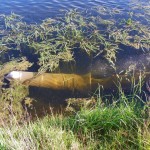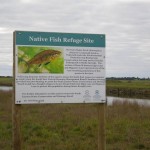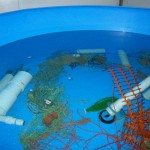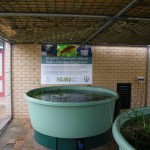
Setting a fyke net for Yarra Pygmy Perch in well vegetated habitat
In 2010/2011 Aquasave undertook further surveys of the Yarra Pygmy Perch (Nannoperca obscura) in the South East of South Australia for the Department of Environment and Natural Resources and provided an update on the recovery efforts that had been undertaken. The Yarra Pygmy Perch is a small freshwater fish which has specialised requirements for deeper, permanent pools and wetlands, with dense vegetation and good water quality. This makes it an ideal biological indicator.
An assessment of the status of Yarra Pygmy Perch in the South East in spring 2010 suggests that the rapid declines of recent years have ceased but that, with the exception of one population, the situation remains critical with limited population recovery in the last 1-2 years. Recovery options for different regions vary from proactive measures to maintain healthy populations through to planning reintroduction.
When a drain is not ‘just a drain’

Lower Drain M site with signage regarding the drain refuge project
Lower Drain M remained the stand out site, containing the healthiest population in the region and potentially the nation. The results reaffirm that drains require recognition as important refuges and alternate function habitat for native biota in a highly modified landscape. The Drain M population expanded locally to recolonise habitats downstream following reasonable flows in 2009 and 2010. Protecting environmental water requirements is therefore an important consideration for any future irrigation or environmental diversions. The refuge habitat created in Drain M will help to protect the population through critically dry times as recently witnessed.
Education through action
Aquasave has been providing support for Yarra Pygmy Perch captive breeding facilities at Kingston Community School and Millicent High School since 2008 and 2010, respectively. These two schools are achieving amazing results through the hard work of dedicated teachers, students and partner organisations. They are providing an important education resource for our local children and critical support to our endangered species. Aquasave worked with the schools providing remote support and undertaking visits to help with:
- general design of the facilities,
- equipment,
- fish health and husbandry, and
- captive breeding and juvenile rearing techniques.
The Kingston Community School facility has successfully bred several hundred juvenile pygmy perch, including offspring from the last Lake Bonney fish, which was an outstanding achievement. While, the Millicent High School facility is newly established, it is now up and running well. These results highlight that the schools are providing not only important environmental education facilities, but are active contributors to threatened species conservation in the South East of South Australia.

Facilities at Kingston Community School’s captive breeding facility

Facilities at Kingston Community School’s captive breeding facility
Under this contract to the Department of Environment and Natural Resources the report Update on the status and recovery efforts for Yarra pygmy perch in South East, South Australia (Hammer 2011) was provided.

